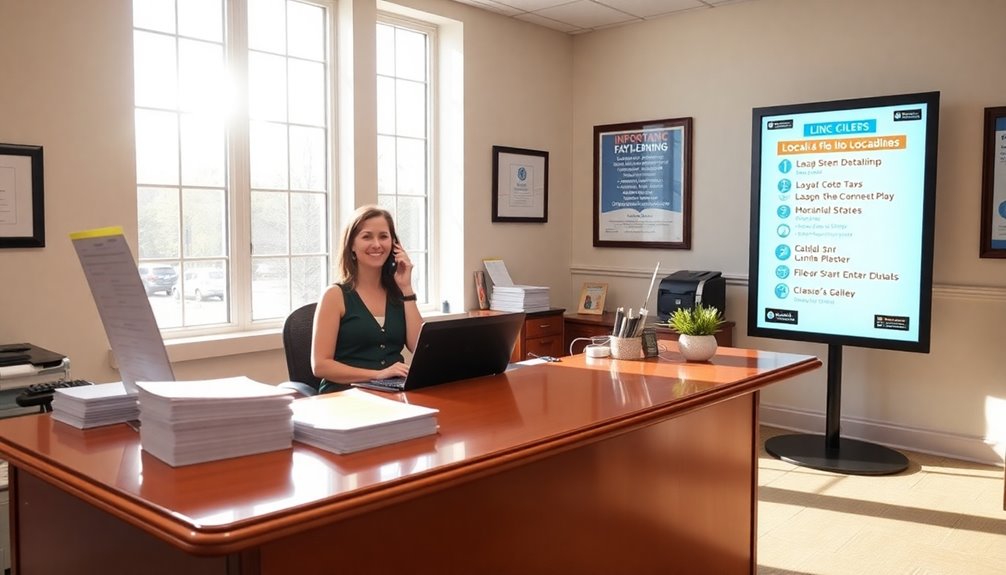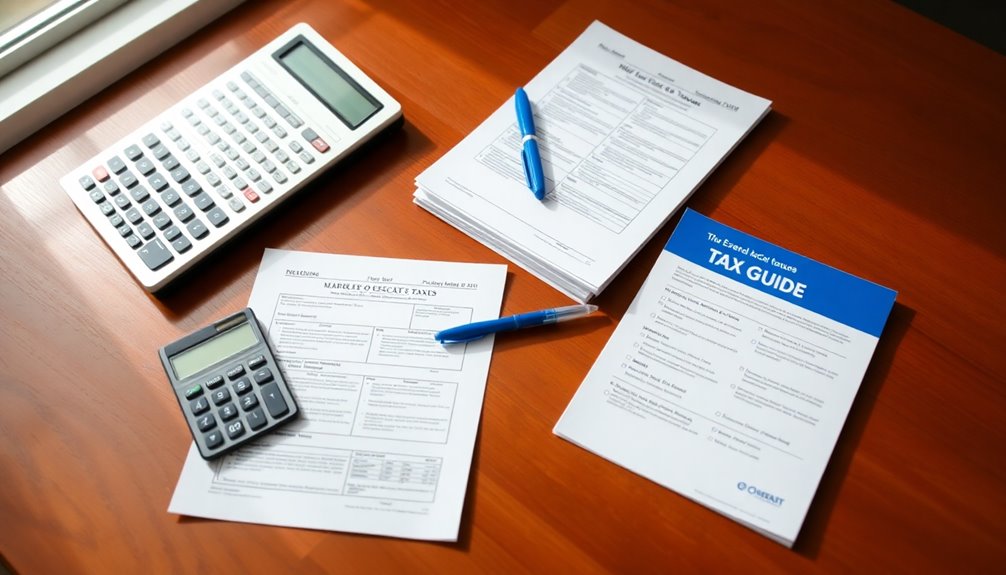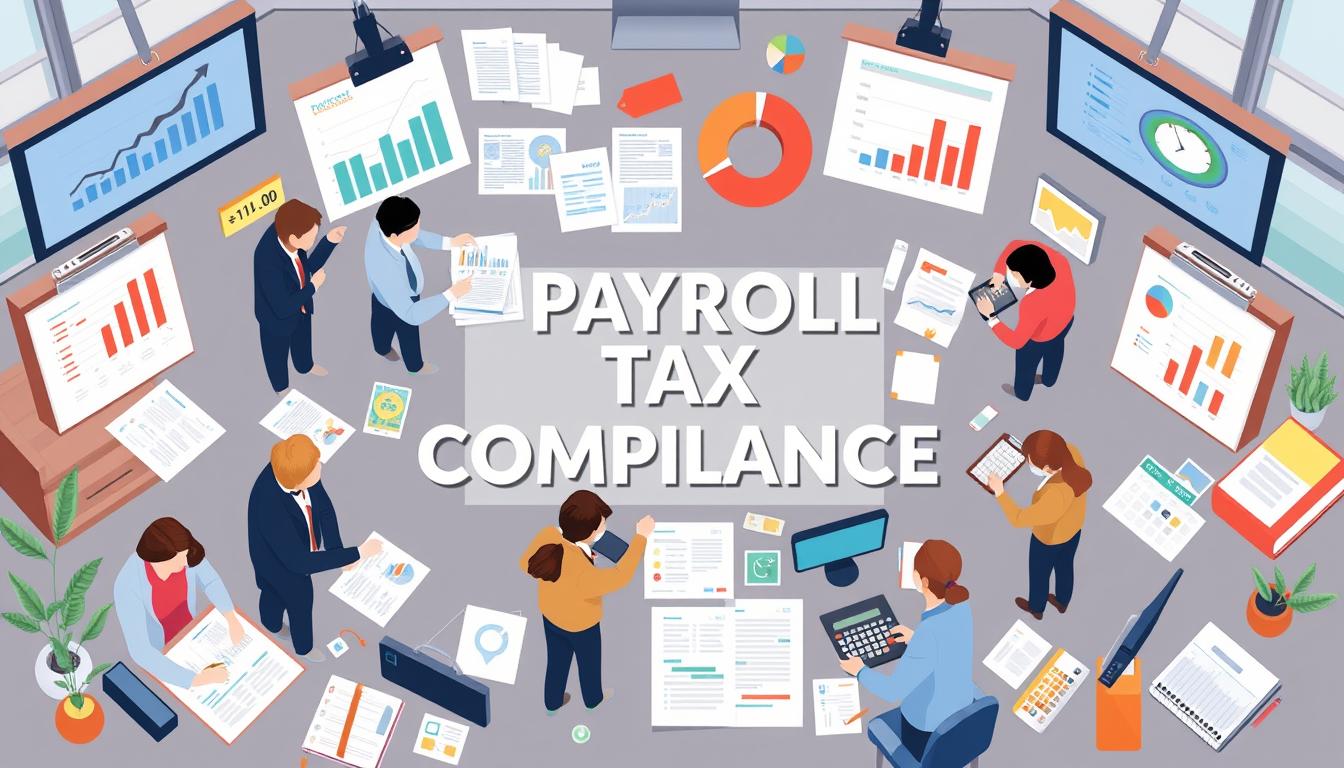To file local taxes in Pennsylvania, start by knowing the deadlines. Your Annual Earned Income Tax Return is due by April 15, with quarterly payments due April 30, July 30, October 30, and January 30. Depending on where you live, you'll file with your local tax collector, either online or by mail. Collect your W-2 forms and other income documentation. If you have special circumstances or exemptions, make sure to understand those too. Utilizing online filing can save you time and reduce errors. Stay informed, and you might discover details that help streamline your tax process even further.
Key Takeaways
- Determine your local tax collection district and file with the appropriate agency, such as York Adams Tax Bureau for Adams residents.
- Gather required documentation including W-2 forms, pay stubs, and any prior year tax credit records before filing.
- Choose your filing method: online via Keystone's e-file system for convenience, or by mail to your local tax collector.
- Be aware of filing deadlines: Annual returns are due by April 15, and quarterly estimated payments are due on specific dates throughout the year.
- Check for any exemptions you might qualify for, such as low-income exemptions or military exemptions, to reduce your tax liability.
Filing Deadlines and Due Dates

Filing your local taxes in Pennsylvania requires attention to various deadlines and due dates to avoid penalties. For individuals, the Annual Earned Income Tax Return is due on April 15. If that date falls on a weekend or holiday, you'll need to file by the following business day.
Keep in mind that if you're making Quarterly Estimated Tax Payments, those are due on April 30, July 30, October 30, and January 30. Additionally, the IRS & PA Department of Revenue have extended tax filing deadlines to May 17, 2021, which can help taxpayers manage their obligations more effectively.
If you need more time, you can request a Pennsylvania Tax Extension, which gives you until October 15, 2024, for Tax Year 2023 filings. However, remember that you must submit your tax return by this extended deadline to avoid late filing penalties.
Employers have specific deadlines, too. The Annual Earned Income Tax Reconciliation is due by February 28, and quarterly returns and payments are due on April 30, July 31, October 31, and January 31.
Also, be aware of the local services tax deadlines, which align with those quarterly dates. Staying on top of these deadlines helps you avoid penalties and ensures you meet your tax obligations effectively.
Where to File

Understanding where to file your local taxes in Pennsylvania is just as important as knowing the deadlines. Each local tax collection district has a specific agency responsible for handling tax filings.
For example, if you're in the Adams Tax Collection District, you'll file with the York Adams Tax Bureau. In Berks, use the Berks Earned Income Tax Bureau, while Bucks residents should go through Keystone Collections Group. If you live in Philadelphia, you'll need to contact the Philadelphia Department of Revenue.
You can file your taxes online through the respective tax collector's website, which streamlines the process by automatically including your Resident PSD Code and calculating your local earned income tax rate. The Scranton Single Tax Office also provides online payment options with varying fees for those who prefer in-person interactions; many districts offer drop box services or designated locations where you can file your taxes directly.
To ensure a smooth filing experience, reach out to your specific tax collection agency for their contact information and available filing options.
Required Documentation

Gathering the right documentation is crucial for a smooth local tax filing experience in Pennsylvania. Start by collecting your W-2 forms, which detail your income and local tax withholding. If you've earned income in different municipalities, pay stubs will help support this.
Don't forget to gather documentation of any out-of-state withholding if it applies to you, along with proof of income earned as a resident in each respective municipality.
Next, you'll need to compile your withholding and tax liability documentation. This includes local taxes withheld as shown on your PA W-2 (Box 19), any tax paid to non-reciprocating states, and records of quarterly estimated payments made for the year. Additionally, employer responsibilities require that tax withheld in one jurisdiction does not necessitate additional payment to another.
Additionally, if you'd any tax credits from the previous year or made extra payments, keep those handy too.
Lastly, prepare any required expense and credit documentation. This might include expense schedules for deductions, proof of local tax obligations, and records for local income tax credits.
If your residency changed during the year, ensure you have a change of address notification and, if necessary, a Residency Certification Form to verify the correct tax rates.
Filing Process

When it comes to filing your local taxes in Pennsylvania, you'll want to ensure you're aware of the key deadlines and methods available to you. Your annual local earned income tax return must be filed by April 15th. If that date falls on a weekend or holiday, the due date shifts to the next business day. Remember, no extensions change the due date for quarterly estimated tax payments.
You can file your return online or by mail. Online filing through Keystone's e-file system is convenient and allows you to use your PC, smartphone, or tablet. This method provides real-time calculations and speeds up processing. Additionally, employer withholding does not exempt you from the requirement to file your local earned income tax return.
If you choose to file by mail, complete the return and send it to your local earned income tax collector. When calculating your tax liability, report your total taxable income and net profit on the return. Make sure to include local income tax withheld from your PA W-2 (Box 19).
You can schedule payments online to ensure they arrive on or before the due date. Lastly, if you're a part-year resident, remember to file separate returns for each municipality.
Special Circumstances

Navigating the nuances of local tax exemptions in Pennsylvania can significantly impact your filing experience. If you earn less than $12,000 annually, you might qualify for a low-income exemption. To claim it, you'll need to file an annual exemption certificate with both your employer and the political subdivision. Ensure your certificate states you expect to earn under the threshold, and attach supporting documents like your pay stubs or W-2 forms. Additionally, local authorities cannot levy taxes on salaries, wages, or earned income of nonresidents in certain school districts, which may further benefit your situation.
If you work multiple jobs within the same municipality, you can still be exempt if you've already paid the LST through another employer. Just provide a pay stub showing that payment when you submit your exemption form.
Active military personnel are exempt from the LST, provided you attach your orders to the exemption form.
Additionally, if you're a student or a part-time worker earning less than $12,000, you may also qualify.
Calculations and Payments

After understanding the special circumstances that may apply to your local tax situation, you'll need to focus on the calculations and payments involved in filing your local taxes in Pennsylvania.
First, determine your taxing jurisdiction by identifying the local tax collection district based on where you live or work. If you've moved during the year, use the Part-Year Resident Schedule for accurate calculations.
Next, calculate your taxable income by adding total income from all sources, including wages and net profits. Adjust for any applicable deductions or exemptions. Remember that the local earned income tax varies significantly across municipalities, which can impact your overall tax liability.
Then, apply the local earned income tax rate specific to your municipality—multiply your taxable income by this rate to find your tax liability.
Don't forget to account for local tax withholdings from your PA W-2 and any local income tax credits you may qualify for.
When it comes time to pay, you can choose from several methods: online payments, mail, or in-person at municipal service centers. Just ensure you follow the correct procedures to avoid penalties and interest on late payments.
Stay organized, and you'll navigate the calculations and payments smoothly.
Online Filing Advantages

One of the top advantages of online filing for your local taxes in Pennsylvania is the convenience it offers. You can access the filing system from any device—be it a PC, smartphone, or tablet—at any time and from any location with an internet connection. Many features don't even require you to create a username or password, making it easier to file, make payments, or respond to department requests.
Online filing also speeds up the entire process. With real-time calculations, you can minimize errors and receive instant confirmation of successfully filed returns. Plus, you'll likely enjoy faster refunds compared to paper returns, reducing the time you spend on paperwork. Furthermore, by ensuring compliance with local tax rates, you can avoid potential penalties that may arise from inaccurate filings.
Another key benefit is the accuracy and compliance it ensures. The system includes automatic error-reducing calculators and guidance on necessary information like PSD codes. This way, you can be confident that the local tax rates and withholdings are accurately determined.
Lastly, you'll find additional support through step-by-step instructional videos and access to customer service, making the online filing experience user-friendly and efficient.
Common Mistakes to Avoid

Many taxpayers encounter pitfalls when filing local taxes in Pennsylvania, which can lead to costly mistakes. One common error is incorrect income reporting. Make sure you report all income accurately, including any active duty military pay and clergy housing allowances, which are exempt from local taxation.
Avoid simply using the federal wage from Box 1 of your W-2, as deductions can skew this figure. Additionally, be aware that employers must withhold local income taxes for all worksites in PA.
Inaccurate tax withholding is another frequent mistake. Don't enter the entire amount from Box 19 of your W-2 if the non-resident tax rate at your workplace is higher than your resident rate.
Be sure to complete the Local Earned Income Tax Withheld worksheet when necessary to ensure accurate credits. Late or incorrect filing can lead to penalties. Always file your returns on time and use the Proration Worksheet if you changed residency during the year.
Additionally, make sure you're compliant with local tax requirements by using the correct PSD codes and registering your business with the appropriate local agency.
Resources for Assistance

When it comes to filing local taxes in Pennsylvania, knowing where to turn for help can make the process smoother. You've got various resources at your disposal.
Start with federal programs like the IRS Free File program, which offers free online guided tax preparation for those with an income of $73,000 or less. If your income is under $58,000, consider the Volunteer Income Tax Assistance (VITA) program for free in-person help. Seniors aged 60 and older can benefit from the Tax Counseling for the Elderly (TCE) program.
For specific questions, the IRS Interactive Tax Assistant is a handy tool. You can also find credentialed paid tax preparers through the IRS's official directory.
At the state level, the Pennsylvania Department of Revenue provides a toll-free FACT and Information Line at 1-888-PATAXES for personal income tax queries. Additionally, 24/7 assistance is available for taxpayers needing support outside regular business hours.
Local municipalities, like the City of Philadelphia and Pittsburgh, offer online filing options and phone assistance.
Don't forget about specialized tools like the Pennsylvania DCED Address Search Application to determine local tax rates. With these resources, you'll be well-equipped to navigate your local tax filing.
Frequently Asked Questions
What Happens if I Miss the Filing Deadline?
If you miss the filing deadline, you'll face consequences like statutory interest and additional costs on any unpaid taxes.
You'll receive a non-payment notice, requiring corrective action within 30 days. If you don't comply, penalties will pile up, and interest will keep accruing.
Late filing and payment penalties can significantly increase your total liability, making it essential to address the situation promptly to minimize costs and avoid further complications.
Can I Amend My Local Tax Return After Filing?
Yes, you can amend your local tax return after filing.
If you discover an error or need to update your information, file an amended return with your local tax collector.
Make sure to check the "Amended Return" box on the form and include any necessary supporting documentation, like W-2s.
It's best to do this within three years of the original due date to avoid penalties and ensure everything's accurate.
Are There Penalties for Filing Incorrectly?
Yes, there are penalties for filing incorrectly.
If you file a false or fraudulent return, you could face a penalty equal to 50% of any underpayment.
Additionally, if you fail to file your return on time, a 5% penalty per month applies, capped at 25%.
It's crucial to ensure accuracy and timeliness when filing to avoid these penalties and potential criminal charges for willful neglect.
Always double-check your information!
How Can I Track the Status of My Tax Return?
To track the status of your tax return, you can use several methods.
First, check the Pennsylvania Department of Revenue's website or log into myPATH for updates.
If you filed through eFile.com, visit your account to see the status.
You can also call the automated information line at 1-888-728-2937.
Just make sure you have your Social Security number and expected refund amount handy for accurate tracking.
What if I Have Income From Multiple States?
If you've got income from multiple states, you'll need to report it all on your PA state income tax return.
Don't worry; you can claim credits for taxes paid to other states to prevent double taxation. Just make sure you document everything properly.
Also, check if local tax credits apply, especially if you're paying taxes in a different jurisdiction.
It's important to stay organized to maximize your deductions!
Conclusion
Filing your local taxes in Pennsylvania doesn't have to be overwhelming. By knowing the deadlines, gathering the right documents, and following the filing process, you can make it a smooth experience. Don't forget to check for special circumstances that might apply to you, and consider online filing for convenience. Avoid common mistakes to ensure accuracy, and don't hesitate to seek assistance if needed. With these tips, you're all set to tackle your local taxes confidently!









